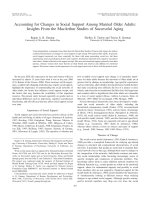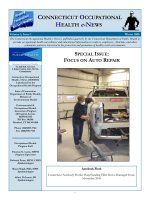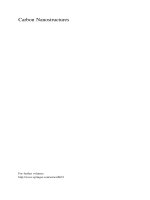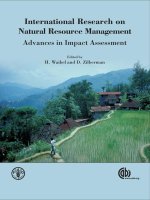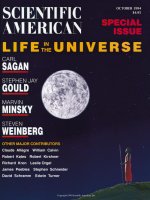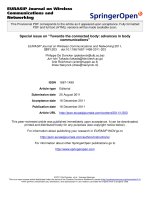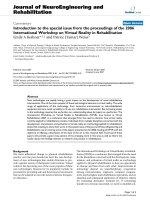Advances in Graph Drawing Special Issue on Selected Papers from the Sixth International Symposium on Graph Drawing, GD98 Guest Editors Foreword
Bạn đang xem bản rút gọn của tài liệu. Xem và tải ngay bản đầy đủ của tài liệu tại đây (88.05 KB, 3 trang )
Journal of Graph Algorithms and Applications
/>vol. 4, no. 3, pp. 1–3 (2000)
Advances in Graph Drawing
Special Issue on Selected Papers from the
Sixth International Symposium on
Graph Drawing, GD’98
Guest Editors’ Foreword
Giuseppe Liotta
Dipartimento di Ingegneria Elettronica e dell’Informazione
Universit`a di Perugia
via G. Duranti 93, 06125 Perugia, Italy
PERS/liotta/liotta.htm
Sue H. Whitesides
School of Computer Science
McGill University
Montreal, PQ H3A2A7, Canada
/>
G.Liotta and S.H. Whitesides, Guest Editors’ Foreword , JGAA, 4(3) 1–3 (2000)2
Introduction
This Special Issue on the Sixth International Symposium on Graph Drawing
(GD’98)1 brings together eight papers based on work presented at the conference. As editors, we chose to invite papers from GD’98 that would reflect the
broad nature of the annual symposia on graph drawing, which showcase theoretical contributions as well as experimental work and visualization systems.
We have also included a contribution based on the GD’98 Graph Drawing
Contest. This contest is an annual conference tradition. Long before the conference takes place, the contest committee posts at the conference web site textual
descriptions of one or more non-trivial graphs, typically with a set of desired
features or requirements for “good” visualizations. Contestants from all over
the world compete for cash prizes, awarded at the conference banquet. The
contest is known for pushing graph drawing technologies to their limits and for
stimulating new research directions.
One of our goals as editors has been to explore the potential of an electronic
journal to convey information that cannot be captured easily by a static medium
such as paper. Hence we are pleased to include two contributions accompanied
by web sites. Since the web sites are maintained by the authors rather than by
the journal, their evolution over time is at the authors’ discretion. An impression
of the original web site, which went through the refereeing process together with
its associated paper, can be gotten either by looking at a “snapshot” version
maintained by the journal or by looking at the paper itself.
All contributions in this Special Issue have been through a rigorous review
process, whether they follow the style of traditional journal papers or whether
they describe working systems or a contest entry. We thank the authors, the
referees, and the editorial board of the journal for their careful work and for
their patience, generosity, and support of our endeavor to explore the potential
of electronic journal publication. We hope that we have captured a bit of the
dynamic quality that the range of research interests presented at the graph
drawing symposia imparts.
Scanning the Issue
Among theoretical contributions, the paper by M. Dillencourt, D. Eppstein, and
D.S. Hirschberg introduces and studies the geometric thickness of a graph, a
notion that lies between the graph-theoretical thickness and the book thickness.
A variant of the well-known binary space partition decomposition defined
in the context of computational geometry is described in the paper by C. A.
Duncan, M. T. Goodrich, and S. G. Kobourov, for the purpose of drawing huge
graphs. They present the balanced aspect ratio (BAR) tree, which supports
1 GD’98 was held August 13-15, 1998, at McGill University, Montreal, Canada. Proceedings
published in the Springer-Verlag Lecture Notes in Computer Science (LNCS) series, vol. 1547,
available on-line at .
G.Liotta and S.H. Whitesides, Guest Editors’ Foreword , JGAA, 4(3) 1–3 (2000)3
recursive division of a graph into subgraphs of roughly equal size, such that the
drawing of each subgraph has a balanced aspect ratio.
The problem of measuring similarities between different drawings of the same
graph is studied in the paper by S. Bridgeman and R. Tamassia, who define a
general framework for quantifying how much a change in a drawing affects the
user’s mental map. This type of study provides basic principles for designing
interactive algorithms for drawing graphs when preserving the mental map is a
priority.
Two of the papers with a strong experimental component deal with orthogonal drawings, i.e. drawings where the vertices are placed at grid points and the
edges are chains of horizontal and vertical segments.
The paper by J. M. Six, K. G. Kakoulis, and I. G. Tollis gives a postprocessing technique called refinement, whose purpose is to improve the readability
of orthogonal drawings in the plane. Their experimental analysis shows significant improvements in such measurable graph drawing aesthetics as area, bends,
crossings, and total edge length.
The paper by G. Di Battista, M. Patrignani, and F. Vargiu studies orthogonal drawings in 3D space and presents a new approach, called split&push, to
compute orthogonal drawings of graphs of maximum degree six. A final drawing
is produced through a sequence of steps: starting from a degenerate drawing,
each step splits the current drawing into two pieces and finds a structure closer
to the final version. The experimental analysis compares the resulting algorithm
with other existing algorithms, taking into account computational time, volume,
average edge length, and average number of bends.
The paper by U. Brandes and D. Wagner is motivated by a very practical application: visualizing timetables of train schedules. They do this with
drawings of graphs whose vertices have fixed positions determined by the geographic locations of the railway stations and whose edges join pairs of stations
connected by non-stop train service. To avoid visual clutter, some edges are
drawn as straight lines, while others are drawn as Bezier curves. Force-directed
methods compute the final visualization.
The paper by P. Eades and Mao Lin Huang presents a strategy intended for
visualizing and navigating in huge graphs. Using this strategy, a user views an
abridgment of a graph, that is, a small part of the graph that is currently of
interest. By changing the abridgment, the user may travel through the graph.
The changes use animation to transform smoothly from one view to the next.
The strategy has been implemented in a prototype system called DA-TU, which
is accessible through the web.
Finally, the paper by U. Brandes, V. K¨
aa¨b, A. L¨
oh, D. Wagner, and T.
Willhalm, chosen to represent the Graph Drawing Contest, shows an example
of dynamic 3D straight-line drawing of directed graphs. The contestants were
given a dynamic graph of links between World Wide Web pages. The goal was
to depict the content as it evolved. The authors use a force directed approach
to create an animation of the given graph. The animation is accessible through
the web.

